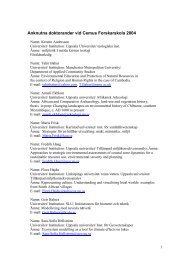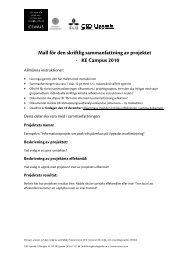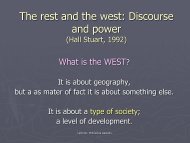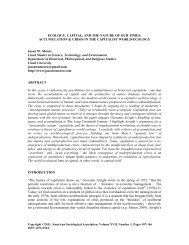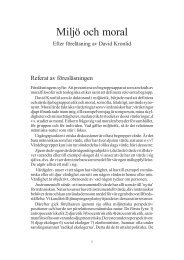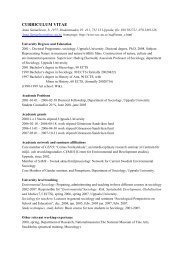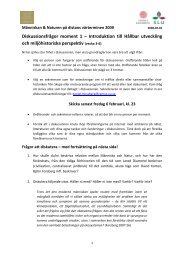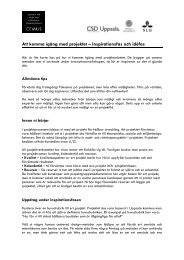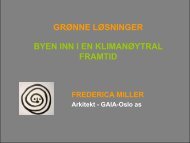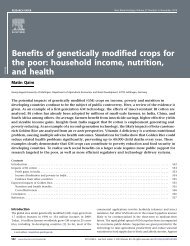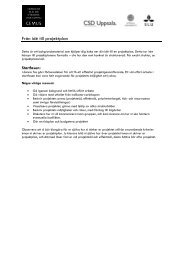The Costs and Benefits of Consuming
The Costs and Benefits of Consuming
The Costs and Benefits of Consuming
Create successful ePaper yourself
Turn your PDF publications into a flip-book with our unique Google optimized e-Paper software.
<strong>The</strong> <strong>Costs</strong> <strong>and</strong> <strong>Benefits</strong> <strong>of</strong> <strong>Consuming</strong>Author(s): Mihaly CsikszentmihalyiSource: <strong>The</strong> Journal <strong>of</strong> Consumer Research, Vol. 27, No. 2 (Sep., 2000), pp. 267-272Published by: <strong>The</strong> University <strong>of</strong> Chicago PressStable URL: http://www.jstor.org/stable/254316Accessed: 09/01/2010 09:11Your use <strong>of</strong> the JSTOR archive indicates your acceptance <strong>of</strong> JSTOR's Terms <strong>and</strong> Conditions <strong>of</strong> Use, available athttp://www.jstor.org/page/info/about/policies/terms.jsp. JSTOR's Terms <strong>and</strong> Conditions <strong>of</strong> Use provides, in part, that unlessyou have obtained prior permission, you may not download an entire issue <strong>of</strong> a journal or multiple copies <strong>of</strong> articles, <strong>and</strong> youmay use content in the JSTOR archive only for your personal, non-commercial use.Please contact the publisher regarding any further use <strong>of</strong> this work. Publisher contact information may be obtained athttp://www.jstor.org/action/showPublisher?publisherCode=ucpress.Each copy <strong>of</strong> any part <strong>of</strong> a JSTOR transmission must contain the same copyright notice that appears on the screen or printedpage <strong>of</strong> such transmission.JSTOR is a not-for-pr<strong>of</strong>it service that helps scholars, researchers, <strong>and</strong> students discover, use, <strong>and</strong> build upon a wide range <strong>of</strong>content in a trusted digital archive. We use information technology <strong>and</strong> tools to increase productivity <strong>and</strong> facilitate new forms<strong>of</strong> scholarship. For more information about JSTOR, please contact support@jstor.org.<strong>The</strong> University <strong>of</strong> Chicago Press is collaborating with JSTOR to digitize, preserve <strong>and</strong> extend access to <strong>The</strong>Journal <strong>of</strong> Consumer Research.http://www.jstor.org
<strong>The</strong> <strong>Costs</strong> <strong>and</strong> <strong>Benefits</strong> <strong>of</strong> <strong>Consuming</strong>MIHALY CSIKSZENTMIHALYI*<strong>Consuming</strong> is defined as behavior whereby entropy is increased in exchange forexistential or experiential rewards. Existential rewards are well known-for example,the satisfaction <strong>of</strong> Maslowian needs. But experiential rewards are perhapsjust as important: these refer to the temporary improvement in positive mood peopleexperience when they are acting in goal-directed, purposeful ways. <strong>Consuming</strong> isone way for obtaining such experiences. It is suggested that in order to evaluatethe impact <strong>of</strong> consuming it is necessary to measure the entropy costs <strong>of</strong> thebehavior balanced against the psychic benefits it provides.A lmost half a century ago, the social philosopherHannah Arendt warned that advances in technology<strong>and</strong> the increase in free time were providing humankindwith the opportunity to consume the whole world. "That. . . consumption is no longer restricted to the necessitiesbut, on the contrary, mainly concentrates on the superfluities<strong>of</strong> life . .. harbors the grave danger that eventually no object<strong>of</strong> the world will be safe from consumption <strong>and</strong> annihilationthrough consumption" (Arendt 1958). At the time these linesmay have sounded like hyperbole. But recent calculationssuggest that if the rest <strong>of</strong> the world's population was todevelop a lifestyle approaching that <strong>of</strong> the United States or<strong>of</strong> Western Europe, at least two additional planets such asours would have to be harnessed to provide the requiredenergy <strong>and</strong> materials. Humans now consume 40 percent <strong>of</strong>all the net photosynthesized biomass produced on the planet,with the developed countries consuming at rates that are<strong>of</strong>ten tenfold those <strong>of</strong> countries with less developedeconomies (Henderson 1999). Since at this time we haveno access to two spare planets to exploit, we should look*Mihaly Csikszentmihalyi is currently the C. S. <strong>and</strong> D. J. DavidsonPr<strong>of</strong>essor at the Peter Drucker School <strong>of</strong> Management <strong>of</strong> the ClaremontGraduate University in Claremont, CA, where he also directs the Quality<strong>of</strong> Life Research Center. Previously he was pr<strong>of</strong>essor <strong>of</strong> psychology at theUniversity <strong>of</strong> Chicago for 30 years. He is best known for his books Flow(1990), Creativity (1996), <strong>and</strong> Finding Flow (1997). Pr<strong>of</strong>essor Csikszentmihalyiis a Fellow <strong>of</strong> the American Academy <strong>of</strong> Arts <strong>and</strong> Sciences, theAmerican Academy <strong>of</strong> Education, <strong>and</strong> the Hungarian Academy <strong>of</strong> Science.Address correspondence to the author at 1021 N. Dartmouth Avenue, Claremont,CA 91711; e-mail: miska@cgu.edu.267more closely at what leads us to consume, in order to betterunderst<strong>and</strong> what motivates this behavior. It is noexaggeration to say that the future <strong>of</strong> the world may dependon it.<strong>The</strong>re are many ways to define "consuming," dependingon what aspect <strong>of</strong> the phenomenon one wishes to highlight.In the present case, I wish to bring attention to the mostinclusive context in which consuming could be viewed: that<strong>of</strong> the physical consequences <strong>of</strong> the process in terms <strong>of</strong>energy exchange. From this point <strong>of</strong> view, a definition mightrun as follows: <strong>Consuming</strong> consists <strong>of</strong> energy expended toimprove the quality <strong>of</strong> life by means <strong>of</strong> increasing entropy.In other words, consuming entails an exchange <strong>of</strong> psychicenergy (usually in its symbolic form, i.e., money) for objectsor services that satisfy some human need. <strong>The</strong>se objects arerelatively high in potential energy to begin with, but throughthe process <strong>of</strong> consuming they are broken down into uselessthings with low potential energy.This definition seems paradoxical in that entropy or thedecay <strong>of</strong> ordered systems <strong>and</strong> objects to more r<strong>and</strong>om stateswith less potential energy is a natural process for whichno energy input is usually needed. <strong>The</strong> Second Law <strong>of</strong><strong>The</strong>rmodynamics specifies that with time entropy mustincrease in all closed systems. So why are we willing topay for something that would happen anyway? Why do wego to great lengths hastening the onset <strong>of</strong> disorder in theuniverse? <strong>The</strong> answer is, <strong>of</strong> course, that we expect to benefitin certain ways from increasing entropy.For example, the steer that produced the rare steak onebuys at the supermarketook a great deal <strong>of</strong> effort <strong>and</strong> energy? 2000 by JOURNAL OF CONSUMER RESEARCH, Inc. 0 Vol. 27 0 September 2000All rights reserved. 0093-5301/2001/2702-0008$03.00
268 JOURNAL OF CONSUMER RESEARCHto raise, feed, butcher, <strong>and</strong> transport. It contains a relativelyhigh number <strong>of</strong> calories, proteins, <strong>and</strong> other substances thatcan be transformed into work. Because <strong>of</strong> this, it has acertain value. After the steak is consumed, however, itsmaterials are broken down into waste with low potentialenergy <strong>and</strong> no value.But as the food is transformed into waste, energy isliberated <strong>and</strong> transferred to the consumer. So the process <strong>of</strong>eating is not wasteful because the energy that went into theproduction <strong>of</strong> the steak goes to increase the diner's energy(however, one might point out that compared to eating otherfoods, eating steaks is relatively more wasteful). By contrast,most consumption provides little or no return <strong>of</strong> this kindto the consumer. Let us imagine, for instance, a father wh<strong>of</strong>eels the need to demonstrate his love for his small son bybuying an expensive electric car for his birthday. Buildingthe car took some raw materials, manufacturing effort, agreat deal <strong>of</strong> marketing, salesmanship, <strong>and</strong> transportationcosts. <strong>The</strong> price tag took a not indifferent bite out <strong>of</strong> thefather's pocketbook. For a few hours the boy plays with thecar, <strong>and</strong> father <strong>and</strong> son have some mildly pleasant time out<strong>of</strong> it. But soon the novelty wears <strong>of</strong>f. <strong>The</strong> car does not runwell on the carpet or the sidewalk, so the boy takes it outmore <strong>and</strong> more rarely. Now it sits in the basement, a uselesshulk slowly turning to rust, taking up space. Is the result <strong>of</strong>such consumer behavior a net increase in entropy or not?Of course if one took into account the entire cycle <strong>of</strong>production <strong>and</strong> consumption we might see a differentpicture. Production entails a negentropic activity one thattakes raw materials <strong>and</strong> turns them into useful goods. Yetproduction also creates disorder in the planetary system:agrobusiness leaves dangerous chemical residues <strong>and</strong>washes away fertile topsoil; manufacture creates pollutants<strong>and</strong> exhausts limited natural resources. So to calculate thenet effect <strong>of</strong> consumption one first needs to add up thepositive outcomes: the increase in order due to productiveprocesses, <strong>and</strong> the improvement in the quality <strong>of</strong> life. <strong>The</strong>none should subtract from this the negative outcomes: theentropy caused by the processes <strong>of</strong> production, <strong>and</strong> theentropy caused by using up the goods produced. If the resultis negative, it means that consumption is accelerating therate <strong>of</strong> decay; if positive, it suggests that it helps theevolution <strong>of</strong> order in the universe. In the present essay, Iam going to focus only on one term <strong>of</strong> this equation: howdoes consumption improve the quality <strong>of</strong> life?HOW CONSUMER BEHAVIOR MEETSEXISTENTIAL NEEDSBecause consumer behavior is largely driven by the desireto satisfy needs that have been programmed in our mindseither by the genes we inherit or the memes' we learn from'A "meme" is a concept introduced by the British biologist RichardDawkins (1976) to refer to programmed behavioral units that are learned,rather than inherited genetically. It derives from the Greek word for imitation,mimesis. Several writers have found the concept useful for describingthe production, selection, <strong>and</strong> transmission <strong>of</strong> cultural information (e.g.,Blackmore 1999: Csikszentmihalyi 1993; Wright 2000).the culture in which we live, it is useful to start the analysiswith a consideration <strong>of</strong> human needs. Of the many taxonomiesdeveloped by psychologists, the one by AbrahamMaslow (1968, 1971) is one <strong>of</strong> the most succinct, <strong>and</strong> onethat is familiar to students <strong>of</strong> consumer behavior (Kilbourne1987). <strong>The</strong> model involves only five factors or levels, <strong>and</strong>it is reasonably comprehensive. We might, therefore, use itto help with a preliminary classification <strong>of</strong> what motivatesconsumer behavior.<strong>The</strong> "Lower" Needs: Survival <strong>and</strong> SafetyAccording to Maslow's theory, the most basic needs thatmotivate a person are physiological survival needs: to eat,drink, have sex, breathe, sleep, be warm, <strong>and</strong> eliminate.When these needs are not met, the person will turn all <strong>of</strong>his or her psychic energy to the task <strong>of</strong> satisfying them. Butas soon as these needs are met, a "higher" set <strong>of</strong> needs willusually attract a person' s attention. A great deal <strong>of</strong> consumerbehavior is directed to satisfy survival needs: food, clothing,<strong>and</strong> shelter being paramount. However, as we shall see later,rarely does a product or service satisfy only basic needs; itis more usual for a whole range <strong>of</strong> lower <strong>and</strong> higher needsto be involved in every consumer exchange.Next on Maslow's hierarchy are safety needs: to live ina stable, predictable environment <strong>and</strong> to be free <strong>of</strong> anxiety.Many consumer decisions are prompted by safety needs,from buying a house in a "good" neighborhood to buyinga h<strong>and</strong>gun or antidepressant drugs. Other exchanges, includingpaying to get an advanced academic degree, or investingin retirement annuities, are also prompted at leastin part by the desire to achieve security.Love <strong>and</strong> BelongingMidpoint in Maslow's scheme, the need for love <strong>and</strong>belonging is rooted in our fear <strong>of</strong> isolation <strong>and</strong> loneliness.Social animals like humans are genetically programmed toseek out the company <strong>of</strong> other members <strong>of</strong> the species. Whenalone (<strong>and</strong> especially when no pressing task dem<strong>and</strong>s attention),the quality <strong>of</strong> experience for most people declines;depression <strong>and</strong> bad mood take over (Csikszentmihalyi1991). In addition to this generic need for human company,human beings have also evolved a more specific desire tobe close <strong>and</strong> to share the experiences <strong>of</strong> one or a few otherpersons, usually <strong>of</strong> the opposite sex. Thus, a need for affection,to love <strong>and</strong> be loved, is also fundamental to humanmotivation.<strong>The</strong> implications <strong>of</strong> this set <strong>of</strong> needs for consumer behaviorare many <strong>and</strong> diverse. For example, bars, restaurants,sport arenas, museums, <strong>and</strong> concert halls provide opportunitiesto mix with others, to see <strong>and</strong> be seen. <strong>The</strong> entireentertainment industry is predicated on experiencing goodtimes vicariously in the company <strong>of</strong> virtual fellow revelers.<strong>The</strong> psychic energy <strong>of</strong> consumers is targeted with ads thatshow masses <strong>of</strong> young people partying on beaches or inbars. If you buy this product, the subtext says, you will nothave to be alone ever again.
THE COSTS AND BENEFITS OF CONSUMING 269<strong>The</strong> need to belong is also served by conformity. Whenwe dress according to fashion, use the latest kitchen appliance,or take a vacation at the "in" resort we feel that weare part <strong>of</strong> a group we aspire to belong to, <strong>and</strong> that we areaccepted by its members. Again, advertising builds heavilyon this need that once was known as "keeping up with theJoneses," but which is apparently as old <strong>and</strong> universal asanything is in human nature.<strong>Consuming</strong> relates to the need to love <strong>and</strong> be loved byproviding opportunities to demonstrate one's feelingsthrough gifts. From extravagant baby showers to elaboratefuneral arrangements, through graduation presents <strong>and</strong> diamondrings, we express our feelings for each other byallowing the loved one to own things that took a great deal<strong>of</strong> energy to make or bring about, so that he or she c<strong>and</strong>ispose <strong>of</strong> it <strong>and</strong> preside over its disintegration.Goods used to express belonging or love have symbolicvalue. It is generally assumed that the more expensive thegift, the greater the appreciation or love felt by the giver,<strong>and</strong> thus the greater the obligation the recipient should feelin return. Thus, the energy expended on the gift is returnedas goodwill. Objects that convey love <strong>and</strong> belonging neednot be valuable in economic terms, however. <strong>The</strong> most cherishedthings in people's homes are rarely items that werebought, but rather things that embody the psychic energy<strong>of</strong> a loved one, like a quilt sewn by one's gr<strong>and</strong>mother, oran athletic trophy won by one's child (Csikszentmihalyi <strong>and</strong>Rochberg-Halton 1980). Thus gifts cannot be reduced tolower-order needs involving instrumental goals <strong>and</strong> calculation<strong>of</strong> exchange; at least occasionally they are expressions<strong>of</strong> relatively selfless agapic love (Belk <strong>and</strong> Coon 1993).<strong>The</strong> Higher Needs: Esteem <strong>and</strong> Self-Actualization<strong>The</strong> need for self-esteem-to feel competent, respected,<strong>and</strong> superior is present already in children, <strong>and</strong> is presumablyactive even when the lower-order needs are not entirelymet. But they become fully active after survival, safety, <strong>and</strong>belongingness needs are more or less taken care <strong>of</strong>. At thatpoint we can indulge in purchasing goods that show ouruniqueness <strong>and</strong> separate us from the rest <strong>of</strong> the crowd. AsBelk (1988) notes, "Evidence supporting the general premisethat possessions contribute to sense <strong>of</strong> self is found ina broad array <strong>of</strong> investigations."Goods that fulfill esteem needs are symbolic in nature,even though they <strong>of</strong>ten serve other motives as well. Forinstance, one's car could be used to drive to work, <strong>and</strong> thussatisfies survival needs; it could also have been purchasedbecause it is safe <strong>and</strong> reliable. But if we pay extra for statusattributes, the car will then become a symbol indicating oursuperiority <strong>and</strong> social worth.Not all objects consumed for esteem reasons are competitivestatus symbols. Many are acquired because theyallow the person to practice <strong>and</strong> perfect a special skill whichis important to his or her identity, such as musical instruments,tools, photo equipment, books that reflect the person'sinterests, sports <strong>and</strong> gardening equipment, <strong>and</strong> s<strong>of</strong>orth. In our study <strong>of</strong> the meaning that household objectshad for their owner, reasons dealing with self-esteem wereamong the most frequently mentioned, sharing first placewith goods that were cherished for reasons <strong>of</strong> belongingness<strong>and</strong> love (Csikszentmihalyi <strong>and</strong> Rochberg-Halton 1980).<strong>The</strong> need for self-actualization, according to Maslow, becomespreeminent after the other four more basic needs aresatisfied. It would seem that <strong>of</strong> all the needs, self-actualizationhas the least predictable impact on consumer behavior.A person driven to achieve personal growth is morelikely to lead a frugal life, perhaps to retire to an ashramor monastery, than to invest heavily in goods. <strong>The</strong> kind <strong>of</strong>persons Maslow used as models <strong>of</strong> self-actualization-ThomasJefferson, Eleanor Roosevelt, Albert Einstein,Albert Schweitzer were not big spenders, <strong>and</strong> inmany ways strove to become independent <strong>of</strong> the market.Yet it has been argued that certain features usually associatedwith the sacred realms <strong>of</strong> life, such as ritual, mystery, <strong>and</strong>communitas, can also accompany mundane consumer behavior(Belk, Wallendorf, <strong>and</strong> Sherry 1989).In fact, on closer look it seems that many consumer decisionsmay be driven by the need for self-actualization.After all, traveling to sit at the feet <strong>of</strong> a genuine Buddhistguru entails buying at least a round-trip airfare ticket toIndia. <strong>The</strong> scholar in his study consumes esoteric knowledgethat is expensive to produce <strong>and</strong> to preserve. Art, music,<strong>and</strong> the appreciation <strong>of</strong> luxury items may also produce transcendentexperiences. Perhaps only a few extremely dedicatedaltruistic individuals, such as Albert Schweitzer,Mother <strong>The</strong>resa, <strong>and</strong> the saintly moral exemplars describedby Colby <strong>and</strong> Damon (1992) can be said to have pursuedself-actualization without increasing entropy in theirenvironment.A yardstick such as Maslow's model suggests that it maybe possible to measure the value <strong>of</strong> consumer behavior interms <strong>of</strong> how various choices satisfy basic existential needs.It may be possible to answer such questions as, How expensive,in terms <strong>of</strong> energy expended, is it to satisfy securityneeds? Or esteem needs? For person X or Y? For a givencommunity or nation? Having such information would allowus to make rational decisions about the value <strong>of</strong> consumerchoices that currently are made without conscious awareness<strong>of</strong> the real costs <strong>and</strong> benefits involved.This would be possible if consumer behavior were drivensolely by the predictable, universal needs that Maslow <strong>and</strong>others have identified. Unfortunately, consumer choices aremade for a variety <strong>of</strong> other reasons that are even less clearlyunderstood <strong>and</strong> that may place just as great a burden onplanetary resources. We might designate this other class <strong>of</strong>needs as experiential needs, to distinguish them from theexistential needs discussed thus far.HOW CONSUMER BEHAVIOR MEETSEXPERIENTIAL NEEDS<strong>The</strong> Maslowian model suggests that individuals are alwaysmotivated by some discrete, specific need for survival,safety, <strong>and</strong> so on. In reality this is not the case. In everyday
270 JOURNAL OF CONSUMER RESEARCHlife, people <strong>of</strong>ten find themselves in an existential vacuumwhere no clear need suggesting a specific goal presents itselfto consciousness. Normal American teenagers, for instance,when they are paged at r<strong>and</strong>om moments <strong>of</strong> the day, report30 percent <strong>of</strong> the time that what they are doing is not whatthey want to do, <strong>and</strong> that they cannot think <strong>of</strong> anything elsethey would rather be doing instead. Although this patternis strongest when teenagers are in school, it is also typical<strong>of</strong> responses at home (Csikszentmihalyi <strong>and</strong> Schneider2000). While we have fewer data from adults, what thereis suggests that they also spend quite a large part <strong>of</strong> theirdays in a state where, as far as they are concerned, "thereis nothing to do."This pattern is significant because when a person feelsthat there is nothing to do, the quality <strong>of</strong> experience tendsto decline. One feels less alert, active, strong, happy, <strong>and</strong>creative. Self-esteem declines. Contrary to what one mightexpect, such a negative experiential state is more likely tooccur at home in free time <strong>and</strong> less <strong>of</strong>ten at work, wheregoals are usually clear <strong>and</strong> attention is more readily engaged(Csikszentmihalyi <strong>and</strong> LeFevre 1989).What this suggests is that in addition to the existentialneeds described by Maslow <strong>and</strong> others, we also have aneed perhaps peculiar to human beings to keep consciousnessin an organized state, focused on some activitythat requires attention. When there is nothing to do <strong>and</strong>attention starts to turn inward, we begin to ruminate, <strong>and</strong>this generally leads to depression. By <strong>and</strong> large, when westart thinking about ourselves rather than about what weneed to accomplish, attention turns to deficits. We are gettingold <strong>and</strong> fat, we are losing our hair, our children don't worshipus as they should, or we haven't accomplished much in life.As a result, our mood begins to turn sour (Csikszentmihalyi1993, 1997; Csikszentmihalyi <strong>and</strong> Figurski 1982). <strong>The</strong>downward spiral <strong>of</strong> rumination is interrupted only whenattention is again engaged by some need that suggests agoal: preparing dinner, taking the dog for a walk, or, if allelse fails, watching the news on TV. Yet trying to fill unstructuredtime with passive entertainment does not workwell; the quality <strong>of</strong> experience while watching TV is barelymore positive than that <strong>of</strong> the slough <strong>of</strong> despond that awaitsthe unfocused mind (Kubey <strong>and</strong> Csikszentmihalyi 1990).<strong>The</strong> experiential need to keep consciousness tuned is responsiblefor a great deal <strong>of</strong> consumer behavior. It could besaid <strong>of</strong> shopping, as MacLuhan said <strong>of</strong> television, "the mediumis the message." In other words, it <strong>of</strong>ten does not matterwhat we are shopping for the point is to shop for anything,regardless. It is a goal-directed activity, <strong>and</strong> thus it fills theexperiential vacuum that leads to depression <strong>and</strong> despair.<strong>The</strong> fact that we have to pay, that is, expend the equivalent<strong>of</strong> psychic energy, for what we acquire lends an additionalimportance to the activity. If we spend money, it must beworthwhile. As Linder (1971) pointed out, the value <strong>of</strong> thegoods we consume in leisure becomes a measure <strong>of</strong> thevalue <strong>of</strong> our time. If in one hour's time I drink $20 worth<strong>of</strong> a single-malt Scotch, while listening to a stereo that depreciatesat the rate <strong>of</strong> $5 an hour, in an apartment whererent prorates at $10 an hour, then it means that my time isworth at least $35 an hour even without counting the cost<strong>of</strong> clothing, furniture, <strong>and</strong> so forth that may also be contributingto the value <strong>of</strong> my time.Thus, consuming is one <strong>of</strong> the ways we respond to thevoid that pervades consciousness when there is nothing elseto do. Shopping <strong>and</strong> surrounding ourselves with possessionsis a relatively easy way to forestall the dread <strong>of</strong> nonbeing,even though it may have serious consequences in terms <strong>of</strong>increasing entropy.Yet consuming, beyond a certain point, seems to contributelittle to a positive experience. Contrary to popularopinion, things that can be bought do not enhance happinessby much. <strong>The</strong> evidence for this statement, while circumstantial,is quite convincing. A number <strong>of</strong> studies show thatbeyond a rather low threshold, material well-being does notcorrelate with subjective well-being (Csikszentmihalyi1999; Diener 2000; Myers 2000). For instance, while theaverage American's income measured in constant dollarshas doubled in the last 40 years, the level <strong>of</strong> happiness theyreport has not changed. Winning the lottery creates a smallblip <strong>of</strong> happiness that lasts a few months, after which thelucky winner's happiness returns to what it was before. Ina current longitudinal study tracking over 800 Americanteenagers through high school <strong>and</strong> beyond, we find that teensfrom the most affluent suburbs tend to be less happy <strong>and</strong>have lower self-esteem than those from middle-class communities,<strong>and</strong> even than those living in inner city slums(Csikszentmihalyi <strong>and</strong> Schneider 2000). Several researchershave shown that excessive concern with financial success<strong>and</strong> material values is associated with lower levels <strong>of</strong> lifesatisfaction <strong>and</strong> self-esteem, presumably because such concernsreflect a sense <strong>of</strong> "contingent worth" predicated onhaving rather than being (Kasser <strong>and</strong> Ryan 1993; Richins<strong>and</strong> Dawson 1992).In one study we correlated the happiness that Americanadults reported experiencing in their free time with theamount <strong>of</strong> fossil <strong>and</strong> electrical energy that the activity theywere doing at the time consumed (Graef, Gianinno, <strong>and</strong>Csikszentmihalyi 1981). If a person was reading a magazinewhen the pager signaled, for example, more energy wasexpended than if he or she had been reading a book, sinceproducing a magazine (in terms <strong>of</strong> manufacturing paper,printing, sales, distribution, <strong>and</strong> so on) requires more BTUs<strong>of</strong> energy per unit <strong>of</strong> reading time than it takes to producea book. Thus if there were a direct relationship betweenenergy consumption <strong>and</strong> quality <strong>of</strong> experience, a personshould be happier when reading a magazine than when readinga book. Instead, we found the opposite: a slight butsignificant negative relationship between the average BTUload <strong>of</strong> activities <strong>and</strong> the happiness people experienced whiledoing them. <strong>The</strong>re was an interesting gender difference: formen BTUs did not relate to happiness at all, whereas forwomen the relationship was quite strong in the negativedirection. According to the Department <strong>of</strong> Energy, about 7percent <strong>of</strong> all the energy consumed in the United States isspent on discretionary leisure activities, from traveling to
THE COSTS AND BENEFITS OF CONSUMING 271snowmobiling, from skiing to TV watching. It is importantto realize, therefore, that a substantial amount <strong>of</strong> this energycould be saved without impairing the quality <strong>of</strong> life, <strong>and</strong>perhaps actually improving it.Why is there a negative relationship between energy consumed<strong>and</strong> happiness? <strong>The</strong> answer to this question maysuggest a new way <strong>of</strong> thinking about consuming, one thatmaximizes the quality <strong>of</strong> experience while minimizing theamount <strong>of</strong> entropy produced as a result. <strong>The</strong> reason activitieswith low external physical energy requirements result ingreater happiness is that they usually require greater inputs<strong>of</strong> psychic energy. Having a good conversation makes verylittle dem<strong>and</strong>s on environmental energy, but it dem<strong>and</strong>s concentratedattention <strong>and</strong> mental activity, <strong>and</strong> can be veryenjoyable. So are activities such as reading, gardening,painting, working on crafts, writing poetry, or doing mathematics.In general, people report being happier when theyare actively involved with a challenging task, <strong>and</strong> less happywhen they are passively consuming goods or entertainment(Csikszentmihalyi 1997, 1999).CONSUMING IN THE THIRDMILLENNIUMEver since Adam Smith, we have learned to say thatproduction is justified by consumption; that the needs <strong>of</strong> theconsumer dictate what the economy should provide (Borgmann2000; Smith [17761 1985). This relationship was soobvious to Smith that he did not believe it was worth arguing;ever since, it has become a mantra <strong>of</strong> economics. Inreality, however, the situation has turned out to be exactlythe opposite: it is the imperative to produce that is dictatingthe need to consume. Economic forecasts are based on increasingdem<strong>and</strong>s: unless people buy more houses, morecars, more sporting equipment <strong>and</strong> clothes, the economywill falter. To buy-even if one does not have the means<strong>and</strong> has to fall ever deeper in debt-is a patriotic act. Torefrain from consuming is antisocial; it is seen as a threatto the community. We have locked ourselves into a viciouscycle that forces us to increase entropy in the environmentwithout providing commensurate value.Is there a way to break out <strong>of</strong> this cycle? Obviously, wecould not simply reduce consuming to the level appropriateto satisfy Maslow's survival <strong>and</strong> safety needs-even if wewanted to-without weakening the productive sector <strong>and</strong>causing unemployment to run rampant. But it might be possibleto reinvent consumption in such a way that it wouldsatisfy both existential <strong>and</strong> experiential needs at minimalenergetic costs while at the same time preserving theeconomy.<strong>The</strong> first step in this direction involves a clear accounting<strong>of</strong> the real costs <strong>of</strong> different consumer choices. Eventuallythis should lead to a new sense <strong>of</strong> good <strong>and</strong> bad, beautiful<strong>and</strong> ugly. If the true entropic costs <strong>of</strong> a sport utility vehiclewere kept in mind, for instance, even the most attractivevehicle <strong>of</strong> that sort would seem indecently coarse. Insteadwe would marvel at the beauty <strong>of</strong> a car made <strong>of</strong> bamboo<strong>and</strong> powered by sunlight. But to facilitate this transformationin taste, it will probably be necessary to legislate a newfiscal policy-one that taxed goods in proportion to theamount <strong>of</strong> entropy their production <strong>and</strong> consumptionentailed.Craftspersons, chefs, athletes, musicians, dancers, teachers,gardeners, artists, healers, poets-these are the workerscreating goods that increase human well-being without degradingthe complexity <strong>of</strong> the world. Is it impossible todevelop an economy based on a majority <strong>of</strong> workers <strong>of</strong> thiskind? Where consumption involves the processing <strong>of</strong> ideas,symbols, <strong>and</strong> emotional experiences rather than the breakdown<strong>of</strong> matter? Let us hope this transition is not impossible,because otherwise the future looks grim indeed. And if thetransition does come about, the Journal <strong>of</strong> Conislumer Researchwill be filled with articles about music, art, poetry,<strong>and</strong> dance-the creative energy <strong>of</strong> the new economy.In the meantime, what suggestions does this perspectiveprovide to those doing research in the field? Perhaps themain message is that ignoring the causes <strong>and</strong> consequences<strong>of</strong> consumer behavior is dangerous. It would be unacceptablefor neurologists to study an addictive drug withouttaking into account the pros <strong>and</strong> cons <strong>of</strong> its use. Similarly,research that deals with consumer behavior without consideringthe context in which it is embedded cannot claim tocontribute to basic knowledge, <strong>and</strong> remains little more thanapplied market research.Science proceeds by developing an agreed-upon set <strong>of</strong>measurements <strong>and</strong> definitions. For consumer research to advancein the direction foreshadowed here, it seems thatagreement on the following dimensions should be useful:What are the costs <strong>of</strong> a specific unit <strong>of</strong> consumer behavior,in terms <strong>of</strong> the consumer? <strong>The</strong> social network <strong>of</strong> which theconsumer is a part? <strong>The</strong> ecological network? Such costsmay best be expressed in the common language <strong>of</strong> entropy.Even though entropy is manifested differently in psychological,social, <strong>and</strong> biological systems, at each <strong>of</strong> these levelsit refers to an increase in disorder <strong>and</strong> loss <strong>of</strong> capacity todo work.To balance the costs <strong>of</strong> consumption we should be ableto measure accurately its benefits. <strong>The</strong>se tend to be <strong>of</strong> anegentropic kind, that is, they involve greater order <strong>and</strong>greater disposable energy at the levels <strong>of</strong> the person, thesocial system, <strong>and</strong> the environment. <strong>The</strong>se benefits are notalways congruent with each other. For instance, the purchase<strong>of</strong> a Ferrari may help the self-esteem <strong>of</strong> an executive pushing50, but cause conflict with his wife.Also, it is important to keep in mind that the relationbetween costs <strong>and</strong> benefits is usually quadratic rather thanlinear. Up to a certain point, material resources add greatlyto the quality <strong>of</strong> life. But where is the point <strong>of</strong> inflectionafter which the relationship may no longer exist, or actuallybecome negative?We already know that material possessions alone do notimprove the quality <strong>of</strong> life. We know that excessive concernfor material goals is a sign <strong>of</strong> dissatisfaction with life. Weknow that trying to avoid the mental chaos <strong>of</strong> everyday life
272 JOURNAL OF CONSUMER RESEARCHby resorting to acquisitions <strong>and</strong> passive entertainment doesnot work very well. Yet we insist in the vain hope that wecan achieve happiness through consumption-regardless <strong>of</strong>consequences. Certainly one <strong>of</strong> the greatest services thatconsumer research can do for humankind is to documentthese realities, <strong>and</strong> diffuse them to as wide a public aspossible.Vague as these concepts are at this point, the progress <strong>of</strong>scholarship in the field will greatly benefit from taking themseriously. Eventually it should be possible to develop reasonablyconvincing cost/benefit analyses for different options,to allow consumers to make choices at a much higherlevel <strong>of</strong> rationality than is possible with current criteria.REFERENCESArendt, Hannah (1958), <strong>The</strong> Human Condition, Chicago: University<strong>of</strong> Chicago Press.Belk, Russell (1988), "Possessions <strong>and</strong> the Extended Self," Journal<strong>of</strong> Consumer Research, 15 (September), 139-168.<strong>and</strong> Gregory S. Coon (1993), "Gift Giving as Agapic Love:An Alternative to the Exchange Paradigm Based on DatingExperiences," Journcal <strong>of</strong> Consumer Research, 20 (December),393-417., Melanie Wallendorf, <strong>and</strong> John Sherry, Jr. (1989), "<strong>The</strong>Sacred <strong>and</strong> the Pr<strong>of</strong>ane in Consumer Behavior: <strong>The</strong>odicy onthe Odyssey," Journal <strong>of</strong> Consumer Behavior, 16 (1), 1-38.Blackmore, Susan (1999), <strong>The</strong> Meme Machine, Oxford: OxfordUniversity Press.Borgmann, Albert (2000), "<strong>The</strong> Moral Complexion <strong>of</strong> Consumption,"Journal <strong>of</strong> Consumer Research, 26 (March), 419-424.Colby, Anne <strong>and</strong> William Damon (1992), Some Do Care: ContemporaryLives <strong>of</strong> Moral Commitment, New York: FreePress.Csikszentmihalyi, Mihaly (1990), Flow: <strong>The</strong> Psychology <strong>of</strong> OptimalExperience, New York: HarperCollins.(1991), "Reflections on the 'Spiral <strong>of</strong> Silence,"' CommunicationYearbook, 14, 288-297.(1993), <strong>The</strong> Evolving Self, New York: HarperCollins.(1997), Finding Flow, New York: Basic.(1999), "If We Are So Rich, Why Aren't We Happy?"Anmerican Psychologist, 54 (10), 821-827.<strong>and</strong> Thomas Figurski (1982), "Self Awareness <strong>and</strong> Aver-sive Experience in Everyday Life," Journal <strong>of</strong> Personality,50 (1), 15-28.<strong>and</strong> Judith LeFevre (1989), "Optimal Experience in Work<strong>and</strong> Leisure," Journal <strong>of</strong> Personality <strong>and</strong> Social Psychology,56 (5), 815-822.<strong>and</strong> Eugene Rochberg-Halton (1980), <strong>The</strong> Meaning <strong>of</strong>Things: Domestic Symbols <strong>and</strong> the Self, New York: CambridgeUniversity Press.<strong>and</strong> Barbara Schneider (2000), Becoming Adults, NewYork: Basic.Dawkins, R. (1976), <strong>The</strong> Selfish Gene, Oxford: Oxford UniversityPress.Diener, Edward (2000), "Subjective Well-Being: <strong>The</strong> Science <strong>of</strong>Happiness," American Psychologist, 55 (1), 34-43.Graef, Ronald, Susan McManama Gianinno, <strong>and</strong> Mihaly Csikszentmihalyi(1981), "Energy Consumption in Leisure <strong>and</strong> PerceivedHappiness," in Consumers <strong>and</strong> Energy Conservation,ed. J. D. Clayton et al., New York: Praeger.Henderson, Hazel (1999), Beyond Globalization, West Hartford,CT: Kumarian.Kasser, Tim <strong>and</strong> Richard M. Ryan (1993), "A Dark Side <strong>of</strong> theAmerican Dream: Correlates <strong>of</strong> Financial Success as a CentralLife Aspiration," Jourtnal <strong>of</strong> Personality <strong>and</strong> Social Psychology,65 (2), 410-422.Kilbourne, William E. (1987), "Self-Actualization <strong>and</strong> the ConsumptionProcess: Can You Get <strong>The</strong>re From Here?" in Philosophical<strong>and</strong> Radical Thought in Marketing, ed. A. F. Firatet al., Lexington, MA: D. C. Heath, 217-234.Kubey, Robert <strong>and</strong> Mihaly Csikszentmihalyi (1990), Television<strong>and</strong> the Quality <strong>of</strong> Life, Mahwah, NJ: Erlbaum.Linder, Stefan (1971), <strong>The</strong> Harried Leisure Class, New York: ColumbiaUniversity Press.Maslow, Abraham (1968), Toward a Psychology <strong>of</strong> Being, NewYork: Van Nostr<strong>and</strong>.(1971), <strong>The</strong> Farther Reaches <strong>of</strong> Human Nature, New York:Viking.Myers, David (2000), "<strong>The</strong> Funds, Friends, <strong>and</strong> Faith <strong>of</strong> HappyPeople," American Psychologist, 55 (1). 56-68.Richins, Marsha L. <strong>and</strong> Scott Dawson (1992), "A Consumer ValuesOrientation for Materialism <strong>and</strong> Its Measurement: Scale Development<strong>and</strong> Validation," Journal <strong>of</strong> Consumer Research,19 (December), 303-316.Smith, Adam ([1776] 1985), An Inquiry into the Nature <strong>and</strong> Causes<strong>of</strong> the Wealth <strong>of</strong> Nations, New York: Modem Library.Wright, Robert (2000), Non-Zero: <strong>The</strong> Logic <strong>of</strong> Human Destiny,New York: Pantheon.



